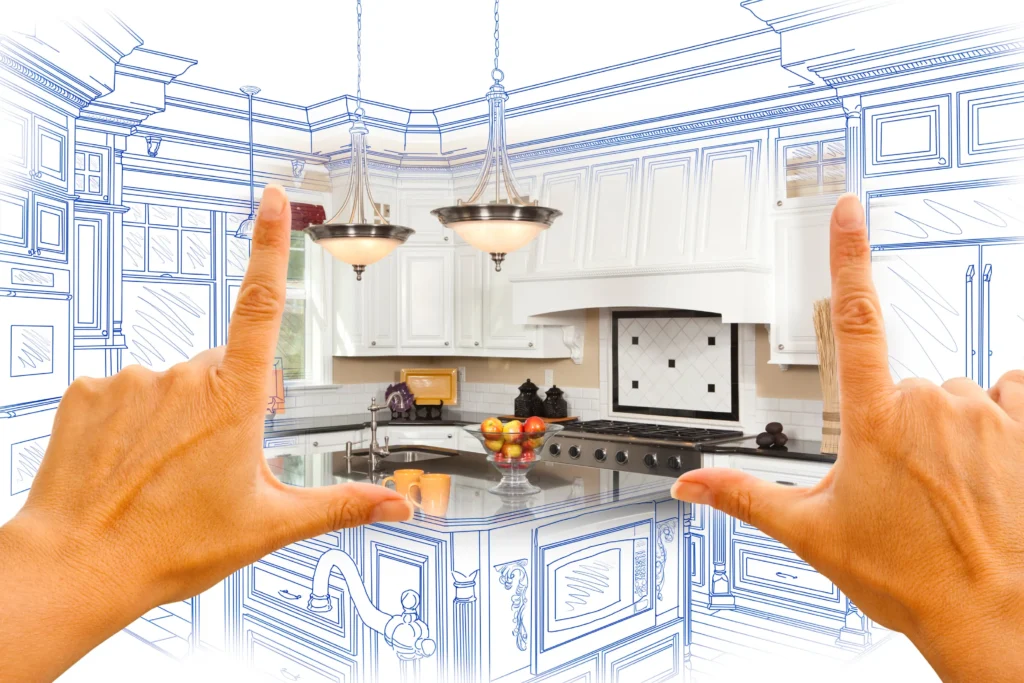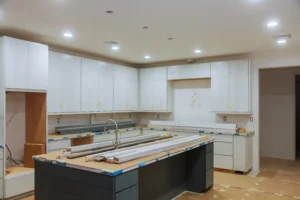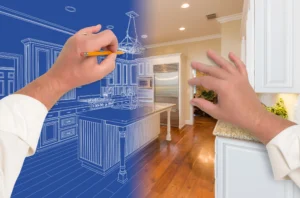The kitchen can be regarded as the core of the household. It is a multifunctional area where culinary activities take place and the family gathers after an exhausting day of work and school.
For the area to give you its full benefits, it has to represent your individual taste and lifestyle. It also has to combine aesthetics with functionality through thoughtful design and organization.
If you are bored with the current look of your meal prep area, then you need to remodel your kitchen to make it look appealing. A culinary space renovation enables you to update various parts of the culinary zone such as appliances, layouts, and cabinetry.
It also enables you to incorporate your desired design trends and personal style, transforming it into a welcoming and visually appealing space.
When looking to make such upgrades, one question you may have is the average timeline it will take to complete the project. This article looks at exactly that by giving a general outline.

Custom Kitchen Design
Planning and Design
This step lays the foundation for the entire project and it entails assessing your needs, setting a realistic budget, and coming up with your desired style, design, and layout of the new space. This process can take anywhere between 2 and 8 weeks and will depend on your specific project and how fast you get things done. Thorough planning is a crucial step because it helps you identify potential challenges and enables for thoughtful decisions regarding aesthetics, materials, detailing, and appliances that can affect delivery and installation times. Engaging a professional architect or contractor can help to streamline this process and make sure that all elements are functional and cohesive. It is also good to mention that collecting permits is part of this step and this can take an extra 1 to 4 weeks to get everything you need.
Demolition
This step marks the transition from the planning to the actual construction phase. It entails removing old appliances, countertops, cabinetry, and flooring. These activities can be quite labor-intensive and time-consuming. This is especially true in older homes where unexpected issues may arise. These can be structural damage or hidden plumbing. Coordinating the demolition process in the best way possible is the only way to reduce potential delays in subsequent phases such as rough-in work and installation. In addition to this, things like site safety and waste disposal must be managed in the right way because they can also affect the overall timelines. Demolition can take a couple of days up to 2 weeks.
Rough-In Work
During this phase, essential infrastructure for electrical, plumbing, and HVAC systems is installed but not yet finished or visible. It entails tasks like running pipes and wires, installing ductwork, and placing fixtures and outlets in the places they are supposed to be. It is an important step because it lays the groundwork for the operation of these systems, ensuring that everything is operating properly before the walls are closed or finished materials are applied. This step can be complex and time-consuming, especially if any structural upgrades to existing systems are required. Properly coordinating the schedules of various workers on site such as plumbers and electricians is paramount to ensure that the job progresses smoothly. Based on the specific undertaking, the rough-in work can last between 1 to 3 weeks.
Installation
Once the rough-in work is done, the next step entails fitting countertops, storage units, appliances, and other fixtures into space. This step can differ in terms of duration and will rely on the complexity of the design, the number of elements being installed, and the coordination required among different experts on the site. Potential delays can come about because of issues like miscommunication, back-ordered materials, and adjustments required to ensure a proper fit. In addition to this, some tasks like installing countertops may require specific curing or setting times that could extend the timeline. By paying attention to such variables allowing for enough time for the installation, as a homeowner, you can minimize disruptions and make sure that everything proceeds smoothly. This step can take 2-6 weeks.
Finishing and Cleaning
This final stage entails tasks like applying paint or finishes, installing backsplashes, and fitting final fixtures like knobs and lighting. Each detail contributes to the overall functionality and aesthetics of the cooking zone so careful consideration is needed. Cleaning is also crucial because it ensures the space is free of dust and debris before being used. This final step can take anywhere between 1 and 3 weeks.
Understanding the average period for a kitchen upgrade is important for effective planning and execution. The process entails a couple of steps including initial planning, demolition, rough-in work, installation, finishing, and cleaning. You can anticipate spending anywhere from 8 to 24 weeks, based on the sophistication of your project. It is good to note that there is a likelihood of experiencing potential delays. Therefore, be sure to plan for them before they happen to ensure a smooth renovation process.




